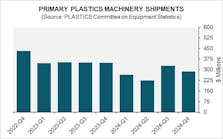By Bruce Geiselman
Artificial intelligence (AI) capabilities aren’t a vision for the future, or just for primary processing equipment anymore.
As Novatec showed at its booth during NPE2024 in Orlando, Fla., AI has plenty of benefits for auxiliary equipment, too. The auxiliary and conveying equipment manufacturer demonstrated some of the potential on its AI-powered DryerGenie resin drying system and SmartConveying system.
Updated DryerGenie adds sensors
Novatec’s DryerGenie uses sensors and AI to calculate exactly how long to dry resins. The technology eliminates the risks of overdrying and underdrying, and minimizes energy consumption, said company President Conrad Bessemer.
The technology features several changes since an early iteration came out last year.
The earlier version used a moisture analyzer array embedded in the nose and handle of a suction probe, or "pick-up lance," that molders use to pull resins from gaylords to the dryer. Feedback from processors was that the sensors’ location put them in harm’s way on the plant floor, so Novatec relocated the resin moisture analyzer stage of the system to a location between the receiver and the hopper, according to the company.
The most significant change to the redesigned DryerGenie is that Novatec added a second sensor array in the form of a probe inside the drying hopper, which the company calls the “drying process scanner stage.”
Because drying parameters are based on conditions beyond the initial moisture content of the material, this secondary stage of the DryerGenie actively monitors the drying process (including the intergranular moisture between the pellets, the temperature and airflow) inside the hopper and dynamically adjusts the dryer’s settings to compensate for any variations.
This second stage ensures that resin is staying on the drying curve tailored by the first stage of the DryerGenie system. The two stages of the re-engineered DryerGenie work together to dry resin in the shortest time possible using the least amount of energy, according to the company.
Traditionally, plastics processors have referred to resin spec sheets to determine the drying time for a resin. However, the moisture content of each batch of resin at the time of processing can vary, forcing operators to engage in what Bessemer called a “guessing game.”
“By precisely pinpointing your resin’s exact moisture content in real time, we’re finally able to eliminate the guesswork, drastically reducing drying times and significantly increasing machine uptime,” Bessemer said.
DryerGenie integrates with many of Novatec’s new dryers, meaning it can be purchased with new dryers or as an upgrade for dryers already in place, according to the company.
SmartConveying powered by VFDs
Novatec’s SmartConveying system eschews variable-frequency drive (VFD) induction motor technology traditionally used in vacuum pumps in favor of vacuum pumps equipped with high-performance motor technology inspired by electric vehicles (EVs), according to the company.
Novatec’s Infinity-series vacuum pumps are powered by InfinityDrive magnetic motors to deliver energy efficiency, material-specific precision, whisper-quiet operation and “hyperspeed” for line blockages, the company said. The motor is devoid of traditional belts and sheaves, which often contribute to operational inefficiencies and maintenance issues, according to the company.
Unlike a conventional VFD industrial motor that operates at a maximum of 100 percent of its rated speed, an InfinityDrive magnetic motor can, for brief periods, operate at up to 150 percent of its rated speed, Bessemer said.
“You can go over speed temporarily, and then slow it down so that you don't fracture the material in the line,” he said.
He compared the feature to what Tesla markets as its “Ludicrous mode” on its EVs.
Combining the EV-type motor technology with Novatec’s FX3 Controller, which employs AI technology for determining motor speed, optimizes operations while safeguarding materials and equipment, according to Novatec.
“This system dynamically adjusts to material characteristics and demand, significantly reducing energy consumption and wear on equipment, but most importantly, it protects your materials, effectively reducing resin stress, breakage and angel hair,” said Ryan Ismirlian, Novatec smart conveying engineer.
The AI system optimizes flow rate based on resin characteristics.
The hyperspeed function, which allows a motor to temporarily operate at a faster-than-normal speed, allows for automated blockage clearing and continuous system operation, he said. In addition, the conveying system’s “near-zero maintenance requirements” reduce downtime and operational costs.
Bessemer outlined numerous advantages of the SmartConveying system equipped with Novatec’s Infinity Series vacuum pumps.
“Historically, you used regular industrial motors,” Bessemer said. “There are windings, and ultimately, they overheat, and they burn up. Also, with a vacuum pump, it becomes very noisy.”
Because of the noise, many factories locate vacuum pumps with traditional industrial motors in back rooms to reduce noise levels on the production floor, he said. When workers enter those rooms, they wear ear protection. However, the new Infinity Series vacuum pumps, used with the SmartConveying system, are significantly quieter.
“You can tell; you’re standing right next to it here. If you have this on the plant floor, you don’t need ear protection,” Bessemer said, referring to a vacuum pump operating on the NPE show floor as part of the company’s SmartConveying demonstration. “It runs under 70 decibels in this operation right now.”
Novatec’s SmartConveying system marks the first time an EV-type motor has been incorporated into a resin conveying system, according to the company.
Contact:
Novatec Inc., Baltimore, 410-789-4811, www.novatec.com
Bruce Geiselman | Senior Staff Reporter
Senior Staff Reporter Bruce Geiselman covers extrusion, blow molding, additive manufacturing, automation and end markets including automotive and packaging. He also writes features, including In Other Words and Problem Solved, for Plastics Machinery & Manufacturing, Plastics Recycling and The Journal of Blow Molding. He has extensive experience in daily and magazine journalism.






